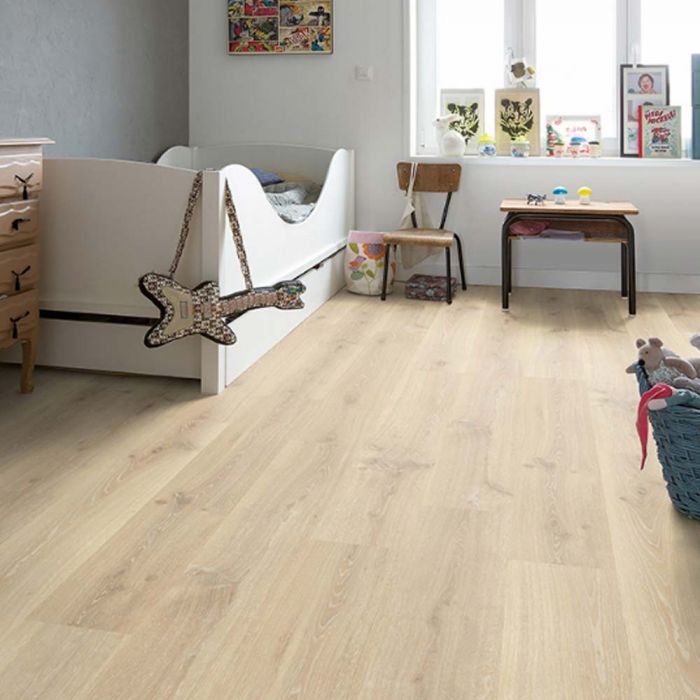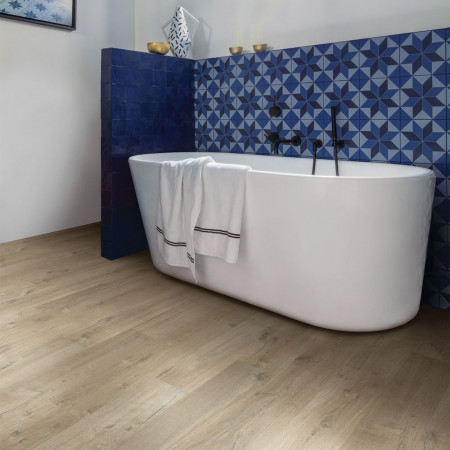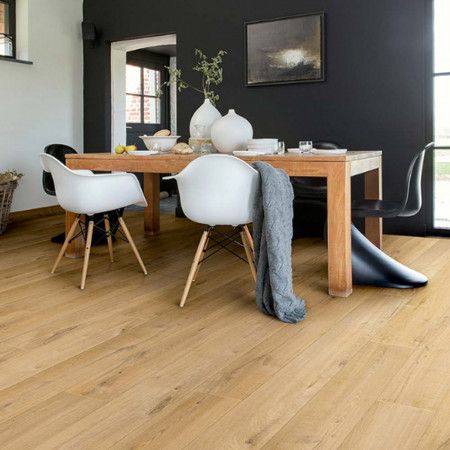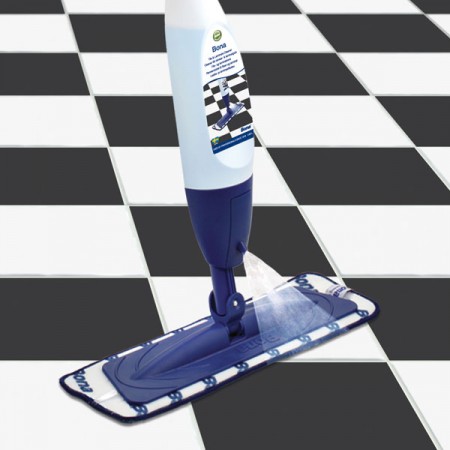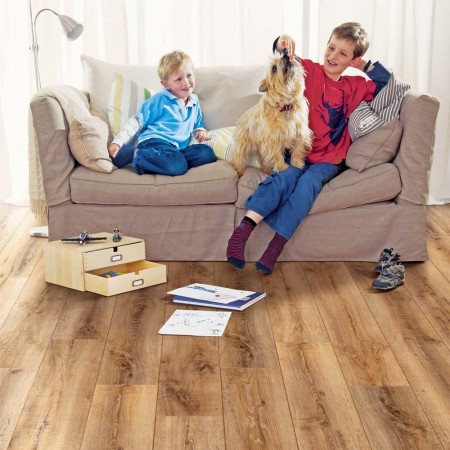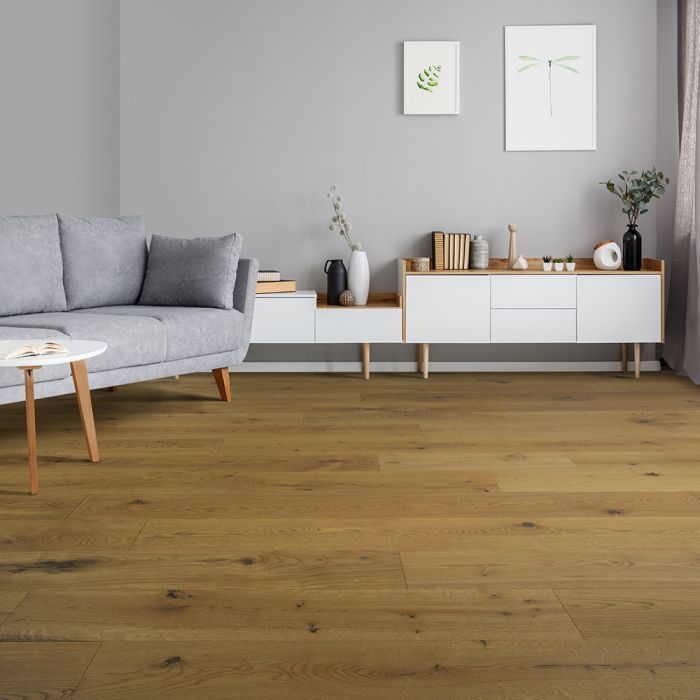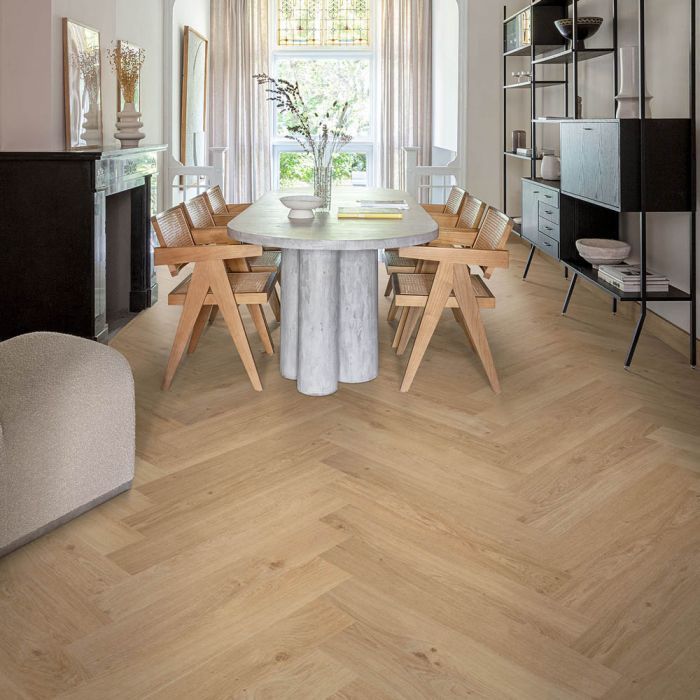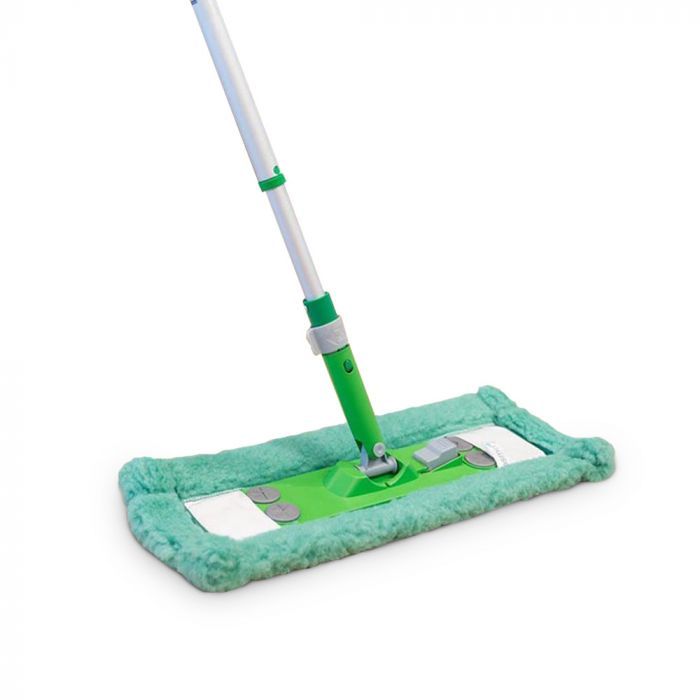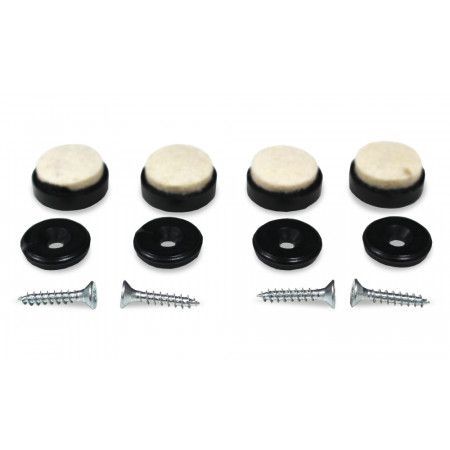Laminate flooring is a synthetic floor covering that has been designed to look like wood flooring or sometimes stone flooring. It has been a popular choice with DIY enthusiasts for decades. Traditionally it offered a cheaper alternative to real wood. Any keen home renovator can install laminate flooring without the need of a professional floor fitter.
In the early days of laminate flooring, the quality was quite poor. Although the idea was that it should mimic hardwood flooring, it was very easy to tell them apart by look and feel. In more recent years the quality of laminate flooring has significantly increased. With reputable manufacturers such as Quick-Step investing in the design and production of their laminate flooring products, more superior and authentic looking styles are available. In recent years there has also been more choice of designs and styles of laminate flooring.
Traditionally laminate was only available in a wood effect. Over more recent years, different designs and effects have been developed to provide you with a wider choice of options. You will be able to choose from effects such as: stone tiles, ceramic tiles and a wide range of different species of wood and bamboo. Someone may easily mistake good quality laminate flooring for a wooden floor. However, laminate flooring does not contain any real wood at all. Each plank is made up of various synthetic layers and topped with a photograph of wood (or stone). The surface layer can sometimes have a built in scratch guard for added protection. The top surface of the floor is water resistant so can cope with the occasional spill or splash. Some types of laminate flooring are even waterproof. Laminate flooring is a great alternative to a real wooden floor. It is, however, important to acknowledge the differences between the two.
It may be useful to have a look at the article: What is the difference between hardwood flooring and laminate flooring?
How is laminate flooring made?
Each different brand of laminate flooring will be made slightly differently. However, the main principles are the same. Laminate flooring is made from multiple layers. The idea is that the finished product will resemble wood, stone or tile flooring. The top of the flooring (the part that you see) is a high definition photograph of your chosen effect. This is usually a type of hardwood but can also be bamboo or stone. The high quality photograph is extremely detailed and looks very authentic. This is covered (or laminated) by a transparent protective surface layer. The surface layer gives the protection that the floor needs to deal with daily wear and tear. A good quality laminate flooring will have a durable surface with built it scratch guard and water resistance. Beneath the photograph is a core layer. This core is usually made from High Density Fibreboard (HDF), which helps to give the flooring some structure. The final and bottom layer is there to balance the floor board. This balancing layer helps to give additional strength to your floor and stops the planks from cupping or bowing when being installed. The finished product is a plank of flooring that has a click fitting system on each edge. Different widths, lengths and thicknesses of planks are available to suit your requirements.
Is laminate flooring easy to install?
Laminate flooring is very easy to install. The best way is to float it over an underlay. You will not need any specialist equipment, glue or nails. This is one of the reasons why it has become so popular with DIY enthusiasts.
Preparing your floor for installation
Before you start fitting your new laminate floor there are a few preparations to undertake. You will need to let your new laminate acclimatise to its surroundings. You should place all of the floor (in the unopened packs) in the middle of the room and leave it until you are ready to install it. It needs to be left for at least 48 hours. The room should be of normal temperature and have no fresh plaster or cement work. You will also need to prepare your existing subfloor. You need to remove your existing floor covering (old laminate, carpet, wood, etc.). The floor needs to be flat, level, dry and clean. Have a look at the following article for further information on preparing your subfloor.
Installing your laminate floor
Once all of your preparations are complete, you are ready to start fitting your laminate floor. You should have already chosen which underlay you require. Either standard or underlay for underfloor heating. Cut this to size and lay it out. Choose where you want to start fitting the laminate and lay down a full plank. Then simply click and lock each plank of flooring into place. In some tight spaces against walls it may be tricky to click the planks together. You may want to use a floor fitting kit for to make it easier. While fitting your laminate floor, remember to leave an expansion space around the perimeter of the room. This includes around pipework and in doorways. The expansion gap should be at least 10mm wide. It helps to ensure that the floor can naturally expand and contract. Once you have fitted your floor the gaps can be covered over by skirting, beading and pipe covers.
Maintaining your laminate floor
Maintaining and looking after your new laminate floor is very easy. Keep it clean by regular sweeping. You can remove more stubborn stains with a wood floor cleaner spray and mop. Remember to wipe away water straight away and protect you floor from damage by using felt protector pads on the bottom of furniture.
Which rooms in my home can I use laminate flooring?
Laminate flooring is extremely versatile. You can use the floor in almost any room in your home. It is built to be durable enough to deal with your daily wear and tear so make a prefect choice for hallways, living areas and bedrooms. You will find beautiful designs of flooring. This will allow you to match it to any décor or theme and will bring a fresh new look to your room. Some types of laminate flooring are water resistant so would be better choices for rooms where some water or drinks may be present, such as dining areas and hallways. Quick-step even have a range of laminate flooring (Hydroseal) that is waterproof and provides 100% resistance to moisture. This is recommended if you choose to have laminate flooring in rooms with a lot of water, like bathrooms, kitchens or utility rooms.
What are the advantages of having laminate flooring?
Laminate flooring is still a very popular choice. It has many benefits and advantages:
• You will be able to find laminate at a much cheaper cost than real wood or stone floors. This makes it very popular for people who have a tight budget or a for rental properties.
• The flooring is strong and durable. It is resistant to stains, impacts and scratches so perfect for busy areas.
• It does not fade in sunlight like some species of wood or natural stone products. This is due to the protective top coating it has.
• You will be able to use most types of laminate flooring with underfloor heating. You will just need to check with the manufacturer and make sure you use the correct underlay. Specific underfloor heating underlay allows for the heat to transfer efficiently.
• As already mentioned, it is a very low maintenance type of flooring. Laminate flooring requires sweeping to remove dust and dirt and only a few precautionary measures to prevent damage. It is very easy to look after.
• Laminate flooring has a click fitting system so is easy to install. Simply fit over an underlay by clicking the planks together. Your floor will then be ready to use straight away.
• There are a huge range of different effects, colours and patterns to choose from. Traditionally laminate flooring was either pale or dark wood. Nowadays you will be able to find this type of flooring in many different styles of wood and stone effect.
• Most types of good quality laminate flooring are water resistant. Some types are even classified as waterproof so it is important to check this before you buy.
• Laminate flooring is available in a range of different plank sizes. With different widths and lengths you are sure to find your perfect floor. There are often different thickness to choose from too. This can be important if you only have a narrow gap underneath doorways.
• It is a very hygienic type of flooring. It is quick and easy to clean and does not allow for a build-up of dust or dirt. If you have allergies then this may be a great choice for you.
• Any type of laminate flooring is ideal for households with pets. The top surface of the flooring is relatively tough and durable. This means that it acts as a scratch resistant layer. There is no need to worry about pet claws marking or scraping your floor.
The options for laminate flooring are endless. Laminate looks like a natural material but at a fraction of the price. It is a very popular flooring choice, and will continue to be due to its low cost, easiness to fit and low maintenance.

